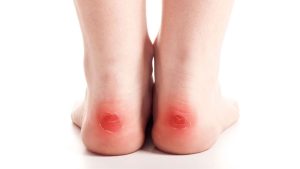When should I see a doctor about a blister?
What is a blister?
Blisters are small pockets of fluid that usually form in the upper layers of skin after it’s been damaged. Blisters can develop anywhere on the body but are most common on the hands and feet. They are usually due to friction against the skin.
Fluid collects under the damaged skin, cushioning the tissue underneath. This protects the tissue from further damage and allows it to heal.
Most blisters are filled with a clear fluid (serum), but may be filled with blood (blood blisters) or pus if they become inflamed or infected.
 Ankle blisters are common after wearing new shoes
Ankle blisters are common after wearing new shoes
Treating blisters – should I pop them?
No. Most blisters heal naturally after three to seven days and don’t require medical help.
It is important to avoid bursting the blister, because this could lead to an infection or slow down the healing process.
If the blister does burst, don’t peel off the dead skin. Instead, allow the fluid inside the blister to drain and cover the area with a dry, sterile dressing to protect it from infection until it heals.
So. When should I see a doctor about a blister?
See your GP if you have blisters that:
- You think are infected or very large
- You have many of them and they are not related to trauma
- Are very painful
- Keep coming back.
Summary
We have described when should I see a doctor about a blister. We hope you understand them better now.

